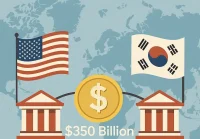The economic squeeze is hitting U.S. middle-income families hard as inflation, rising costs, and stagnant wages erode their financial stability. Once considered the foundation of the American economy, these households are now grappling with shrinking purchasing power and an uncertain future.
Despite recent signs of easing inflation, the economic squeeze continues in critical areas such as housing, groceries, healthcare, and credit. Real wages remain flat, while debt levels rise, pushing many families closer to financial distress.
This prolonged economic squeeze is changing how middle-income Americans live, save, and plan for the future. Without meaningful policy intervention or wage growth, the pressure on these families is unlikely to ease any time soon.
Table of Contents
Inflation’s Lingering Bite
According to the U.S. Bureau of Labor Statistics, core inflation remained at 3.4% as of April 2025 still well above the Federal Reserve’s 2% benchmark. While the peak inflation of 2022 may be behind us, prices have not returned to pre-pandemic levels.
A Pew Research Center report found that 60% of middle-income households those earning between $50,000 and $150,000 annually say their incomes have not kept pace with the rising cost of living. More than 70% have reduced discretionary spending, and nearly one in three report turning to credit cards or dipping into savings to cover essentials.
“While inflation has slowed, it hasn’t reversed,” says Diane Swonk, chief economist at KPMG. “Middle-income Americans are still paying significantly more for everyday needs compared to just a few years ago.”

A Cooling Economy Deepens the Economic Squeeze
As inflation persists, the U.S. economy is also losing steam. The country’s GDP grew at just 1.2% in Q1 2025, down sharply from 3.1% a year ago. Economic uncertainty has led to waves of layoffs in key middle-class employment sectors, including tech, retail, and finance.
The Federal Reserve’s elevated interest rates held high in an attempt to tame inflation—have triggered a cascade of financial pressures:
- Mortgage rates hovering around 6.9%
- Credit card APRs exceeding 21%
- Rising student loan repayments following the expiration of forbearance programs
This trifecta of pressures is pushing middle-class households to the financial brink even for those with steady jobs.
Wages Lag Behind Reality
Despite low unemployment, real wage growth has failed to keep pace with inflation. According to the Federal Reserve Bank of St. Louis, median household income fell by 2.8% in 2023 when adjusted for inflation and remained flat through early 2024.
Meanwhile, essential costs continue to climb:
- Health insurance premiums up 7.1% year over year (Kaiser Family Foundation)
- Childcare expenses averaging over $13,000 per child annually
- Groceries up 18% cumulatively since 2021 (USDA)
A Bankrate survey revealed that 57% of Americans earning $100,000 or more now live paycheck to paycheck, underscoring the shrinking safety net even for higher-earning middle-class families.
“It’s not just working-class Americans feeling the crunch,” says Mark Zandi, Chief Economist at Moody’s Analytics. “The middle class is being hollowed out by inflation, high interest rates, and stagnant incomes.”
Pain Points: Housing, Food, and Family Costs
Housing Pressures
- Median U.S. home price: $431,000 (Zillow, May 2025)
- Mortgage rates near 7%, making homeownership less accessible
- Rent prices up 14% since 2021, exceeding the affordability threshold in many urban areas
Everyday Essentials
- Grocery bills remain elevated, especially for meat, dairy, and produce
- Utility costs have plateaued but remain well above 2019 levels
Family and Childcare
- Childcare costs now outpace college tuition in many regions
- Health insurance and out-of-pocket medical costs are consuming a larger share of household income
Middle-Class Survival Strategies
As expenses rise and incomes stagnate, many families are turning to debt, downsizing, or relocation to make ends meet.
Key coping mechanisms include:
- Rising credit card debt, now exceeding $1.3 trillion nationally (New York Fed)
- Moving to lower-cost states or multigenerational living arrangements
- Delaying major purchases, travel, and even healthcare
- Taking on second jobs or gig work to supplement income
“We’re not poor, but we’re not safe either,” says Amanda, a teacher from Ohio earning $62,000 annually. “Every month feels like a tightrope walk.”
Is Relief in Sight?
The Federal Reserve has hinted at a possible pause in interest rate hikes, but no major federal relief packages appear imminent. Attempts to expand child tax credits or increase affordable housing initiatives remain bogged down in political gridlock.
Meanwhile, middle-class Americans are being asked to simply “hold on”—but for many, there’s little left to hold onto.
With the 2026 midterms on the horizon, economic insecurity among middle-income voters is poised to be a major political flashpoint.
Looking Ahead: Redefining the American Middle Class
The term “middle class” has long evoked images of stability, homeownership, and upward mobility. But for many in 2025, it now represents financial vulnerability, limited flexibility, and the constant stress of “just getting by.”
As policymakers, economists, and businesses assess the future, one thing is clear: America’s middle class is no longer immune to the broader economic turbulence. Addressing their needs may be key not only to future recovery, but to preserving the nation’s economic identity itself.
Stay Informed with WhatJobs News
For more data-driven stories on the U.S. economy and labor market, visit WhatJobs News.
Frequently Asked Questions (FAQs)
Why Is the U.S. Middle Class Under Financial Pressure in 2025?
The economic squeeze is tightening on America’s middle class in 2025. This group is being hit hardest by a combination of persistent inflation, elevated interest rates, and a cooling economy. Essential costs like housing, healthcare, and groceries continue to outpace wage growth, eroding purchasing power and increasing financial strain.
Inflation’s Role in the Economic Squeeze
Has inflation gone down?
Yes, inflation has cooled from its 2022 peak, but the economic squeeze hasn’t eased much. Prices remain high, and core inflation is still above the Federal Reserve’s 2% target. While the rate of increase has slowed, many everyday items and services remain unaffordable for middle-income households.
How Middle-Class Families Are Coping with the Economic Squeeze
Many families are adjusting to the economic squeeze by making difficult financial choices. These include relying more heavily on credit cards, postponing major purchases like homes or cars, moving to lower-cost regions, or taking on second jobs and gig work to cover rising expenses.
Is the Government Offering Any Relief?
In response to the economic squeeze, some state and federal measures have been introduced, such as temporary tax credits, stimulus programs for housing, and student loan relief. However, critics argue these efforts are either too limited or short-term to truly ease the long-standing financial pressure on middle-income Americans.




